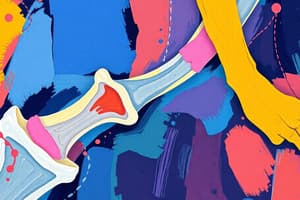Podcast
Questions and Answers
Which type of IV fluid is most appropriate for a patient experiencing hyperkalemia?
Which type of IV fluid is most appropriate for a patient experiencing hyperkalemia?
- Isotonic fluids
- Colloid fluids
- Hypotonic fluids
- Hypertonic fluids (correct)
What is a common cause of fluid deficit in patients?
What is a common cause of fluid deficit in patients?
- Renal failure
- Excessive vomiting (correct)
- Overhydration
- Heart failure
Which of the following laboratory findings is typically expected in chronic kidney disease (CKD)?
Which of the following laboratory findings is typically expected in chronic kidney disease (CKD)?
- Decreased glomerular filtration rate (GFR) (correct)
- Normal electrolyte levels
- Increased blood urea nitrogen (BUN) (correct)
- Decreased serum creatinine
Which type of incontinence is characterized by involuntary loss of urine due to increased intra-abdominal pressure?
Which type of incontinence is characterized by involuntary loss of urine due to increased intra-abdominal pressure?
What is a priority intervention for a patient who has just been diagnosed with a new GI bleed?
What is a priority intervention for a patient who has just been diagnosed with a new GI bleed?
What is a common complication that can occur post-operatively, especially in patients who have undergone ORIF procedures?
What is a common complication that can occur post-operatively, especially in patients who have undergone ORIF procedures?
Which of the following is NOT a typical symptom of osteoporosis?
Which of the following is NOT a typical symptom of osteoporosis?
What is a critical nursing intervention to address before notifying a provider about a post-op patient with lower extremity pain?
What is a critical nursing intervention to address before notifying a provider about a post-op patient with lower extremity pain?
Which pharmacological approach can be used for managing pain in postoperative patients?
Which pharmacological approach can be used for managing pain in postoperative patients?
In patients with metabolic syndrome, which laboratory value is most commonly elevated?
In patients with metabolic syndrome, which laboratory value is most commonly elevated?
What is a recommended treatment for managing sleep apnea?
What is a recommended treatment for managing sleep apnea?
Which of the following would least likely impede sleep hygiene?
Which of the following would least likely impede sleep hygiene?
What is a major impact of smoking on wound healing?
What is a major impact of smoking on wound healing?
Flashcards
Types of fractures
Types of fractures
Different ways a bone can break, categorized by the way the bone breaks.
Osteoporosis
Osteoporosis
A bone disease that weakens bones, increasing the risk of fractures.
Osteomyelitis
Osteomyelitis
Infection of the bone and bone marrow.
Compartment Syndrome
Compartment Syndrome
Signup and view all the flashcards
DVT
DVT
Signup and view all the flashcards
Rhabdomyolysis
Rhabdomyolysis
Signup and view all the flashcards
Parenteral feedings
Parenteral feedings
Signup and view all the flashcards
Refeeding syndrome
Refeeding syndrome
Signup and view all the flashcards
IV Fluid Types
IV Fluid Types
Signup and view all the flashcards
Fluid Deficit (Causes)
Fluid Deficit (Causes)
Signup and view all the flashcards
Hyperkalemia Treatment
Hyperkalemia Treatment
Signup and view all the flashcards
Chronic Kidney Disease (CKD) Stages
Chronic Kidney Disease (CKD) Stages
Signup and view all the flashcards
Uric Acid Kidney Stones - Causes
Uric Acid Kidney Stones - Causes
Signup and view all the flashcards
Study Notes
Bone Disorders
- Bone disorders covered include fracture types (matching), osteoporosis, osteomyelitis, and gout.
- Application-level questions involve compartment syndrome, osteomyelitis, deep vein thrombosis (DVT), and rhabdomyolysis.
- A case study focuses on a post-operative ORIF patient with lower extremity pain and redness, requiring assessment of the complication, pre-provider notification steps (3 interventions), and a SBAR report to the provider based on assessment data.
Perioperative Care
- Content focuses on patient education (pre-op, post-op, and discharge instructions), including smoking cessation, warning signs/symptoms before surgery, when to start discharge teaching, and prevention/management of post-op complications (pneumonia, DVTs).
- Pain management strategies using IV and oral medications based on patient symptoms/orders are included.
- Informed consent procedures and when to involve the surgeon for patient pre-operative visits are covered.
Sleep
- Sleep study includes topics like sleep apnea (signs, symptoms, and treatments - CPAP and non-CPAP), sleep deprivation (signs/symptoms), sleep hygiene (best practices), and a bonus question on heart rate changes in relation to age and fitness level.
Nutrition
- Nursing considerations for patients on parenteral and enteral feedings (patient safety, PPN vs. TPN vs. tube feeds) are highlighted, along with the metabolic syndrome concept.
- Diagnostic studies (fasting glucose, vital signs, and labs) and symptoms of low albumin levels linked to nutritional status are included.
Skin
- Learning objectives cover guidance and recommendations on sunscreen use, wound healing impact by smoking, the role of the skin and the signs and symptoms of atopic dermatitis.
Fluid and Electrolytes
- Content covers differences between hypo/hyper/isotonic fluids, IV fluid types (referencing a guide), and clinical manifestations/causes of hypo/hyper issues, including hyperkalemia treatment.
- Application-level questions focus on fluid deficit/excess causes.
Renal
- Kidney function-related labs for chronic kidney disease (CKD) and expected findings are included.
- Causes, clinical presentation for acute kidney injury (AKI) phases, chronic kidney disease (CKD) stages, and uric acid kidney stones are covered.
- Medications for chronic kidney disease and contraindications are mentioned.
- Assessment data prior to medication administration (lab values, physical assessment) is also addressed.
GU
- Information includes incontinence types, treatments, nursing considerations, and nursing interventions.
GI
- Topics encompass lower vs. upper G.I. bleeds, assessment findings related to fluid volume deficit, priorities in the case of a new G.I. bleed, Crohn's disease, ulcerative colitis, and fistulas.
- GERD medications and treatments including H2 blockers and PPIs are discussed.
- A case study involves applying ADPIE to a patient with abdominal pain, where students need to diagnose the problem and predict elevated lab values.
Studying That Suits You
Use AI to generate personalized quizzes and flashcards to suit your learning preferences.



